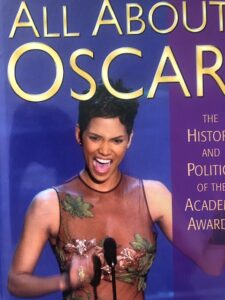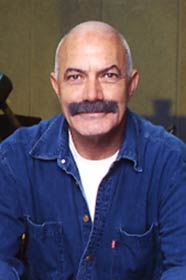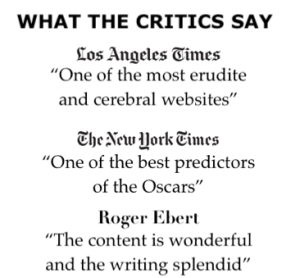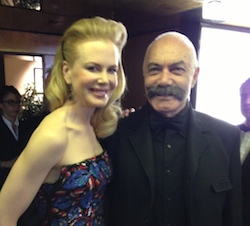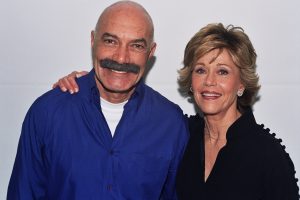Sexual Orientation: Whale as Openly Gay
Whale lived as openly gay man in the British theatre and in Hollywood, which was virtually unheard of in that era.
He and partner David Lewis, a film producer, lived together as a couple from 1930 to 1952.
There have been suggestions that Whale’s career was terminated because of homophobia, and Whale was supposedly dubbed “The Queen of Hollywood,” but others claim that nobody made a thing out of it as far as I could perceive.
Some film historians and gay studies scholars have detected homosexual themes in Whale’s work, particularly in Bride of Frankenstein in which creative people associated with the cast, including Ernest Thesiger and Colin Clive, were alleged to be gay or bisexual.
Some scholars have identified gay sensibility in the film, even camp sensibility, embodied in the character of Pretorius (Thesiger) and his relationship with Henry Frankenstein (Clive).
Gay film historian Vito Russo does not identify the character as gay, but referred to him as “sissified” (“sissy” being Hollywood’s gay stock character. Pretorius serves as a “gay Mephistopheles,” a figure of seduction, pulling Frankenstein away from his bride on their wedding night to engage in unnatural act of non-procreative life.
A novelisation of the film published in England made the implication clear, having Pretorius say to Frankenstein “‘Be fruitful and multiply.’ Let us obey the Biblical injunction: you of course, have the choice of natural means; but as for me, I am afraid that there is no course open to me but the scientific way.”
Was Whale’s homosexuality expressed in Frankenstein and Bride as “a vision both films had of the monster as an antisocial figure in the same way that gay people were ‘things’ that should not have happened.”
Whale’s partner David Lewis stated that Whale’s sexual orientation was “not germane” to his filmmaking. “Jimmy was first and foremost an artist, and his films represent the work of an artist—not a gay artist, but an artist.”
Whale’s biographer Curtis rejects the notion that Whale would have identified with the Monster from homosexual perspective, stating that if the class-conscious Whale felt as an antisocial figure, it would have been based not in his sexuality but in his lower classes origins.
Visual Style
Influenced by German Expressionism, Whale admired the films of Paul Leni, which combined elements of gothic horror and comedy. This influence was most evident in Bride of Frankenstein.
Expressionist influence is also in Frankenstein, drawn in part from the work of Paul Wegener and his films The Golem (1915) and The Golem: How He Came into the World (1920), along with Robert Wiene’s The Cabinet of Dr. Caligari (1920), which Whale screened repeatedly while preparing to shoot Frankenstein.
Frankenstein alternates between distorted expressionistic shots and more conventional styles–the character of Dr. Waldman serving as a bridge between everyday and expressionist spaces.
Expressionist influence is also evident in the acting, costuming and the design of the Monster. Whale and makeup artist Jack Pierce were inspired by the Bauhaus school of design.
Whale’s final film, Hello Out There, was praised by Sight & Sound as “a virtuoso pattern of light and shade, a piece of fully blown expressionist filmmaking plonked down unceremoniously in the midst of neo-realism’s heyday.”
Whale was known for his camera movements, credited as the first director to use a 360-degree panning shot in a feature, included in Frankenstein.
Whale used a similar technique during the Ol’ Man River sequence in Show Boat, in which the camera tracked around Paul Robeson as he sang the song. (The sequence also uses expressionist montages illustrating some of the lyrics.)
Frankenstein: the series of shots that introduce the Monster: “Nothing can ever quite efface the thrill of watching the successive views Whale’s mobile camera allows us of the lumbering figure.” These shots, starting with a medium shot and culminating in two close-ups of the Monster’s face, were repeated by Whale to introduce Griffin in The Invisible Man and the abusive husband in One More River.
Modified to a single cut rather than two, Whale uses the same technique in The Road Back to signal the instability of a returning World War I veteran.
Personal
Whale returned to California in November 1952 and and told David Lewis that he planned to bring Foegel over. Appalled, Lewis moved out of their home. While this ended their 23-year romantic relationship, they remained friends. Lewis bought a small house and dug a swimming pool, prompting Whale to have his own pool, though he did not swim in it. He began throwing all-male swim parties and would watch the young men cavort in and around the pool.
Foegel moved in with Whale in early 1953 and remained there for months before returning to France. He returned to California in 1954 permanently, and Whale installed him as manager of a gas station that he owned.
Whale and Foegel settled into a routine life until the spring of 1956, when Whale suffered small stroke. A few months later he suffered larger stroke and was hospitalized, and treated for depression with shock treatments.
Upon his release, Whale hired a male nurse from the hospital to be his personal live-in nurse. A jealous Foegel maneuvered the nurse out of the house and hired a female nurse as non-live-in replacement. Whale suffered from mood swings and grew increasingly dependent on others as his mental faculties were diminishing.
Death: Suicide
Whale died by suicide, drowning himself in his Pacific Palisades swimming pool on May 29, 1957 at age 67.
He left a suicide note, which Lewis withheld until his own death decades later. Because the note was suppressed, the death was initially ruled accidental.
The note read in part:
To ALL I LOVE,
Do not grieve for me. My nerves are all shot and for the last year I have been in agony day and night—except when I sleep with sleeping pills—and any peace I have by day is when I am drugged by pills.
I have had a wonderful life but it is over and my nerves get worse and I am afraid they will have to take me away. So please forgive me, all those I love and may God forgive me too, but I cannot bear the agony and it [is] best for everyone this way. The future is just old age and illness and pain. Goodbye and thank you for all your love. I must have peace and this is the only way.— Jimmy.
Whale’s body was cremated per his request, and his ashes interred in the Columbarium of Memory at Forest Lawn Memorial Park, Glendale.
He had the habit of revising his date of birth, with incorrect date of 1893.
When longtime partner David Lewis died in 1987, his executor and Whale biographer James Curtis had his ashes interred in a niche across from Whale’s.
Legacy
Influential film critic Andrew Sarris, in his 1968 ranking of directors, lists Whale as “lightly likable.” Whale’s reputation has been subsumed by the “Karloff cult,” Sarris cites Bride of Frankenstein as the “true gem” of the Frankenstein series. He notes that Whale’s career “reflects the stylistic ambitions and dramatic disappointments of expressionist in the studio-controlled Hollywood of the thirties”.
American post-punk band Tuxedomoon recorded a song James Whale on their debut studio album Half-Mute, released March 15, 1980.
Whale’s final months are depicted in the 1995 novel, “Father of Frankenstein” by Christopher Bram. The novel focuses on the relationship between Whale and a fictional gardener named Clayton Boone. Father of Frankenstein served as the basis of the 1998 film Gods and Monsters with Ian McKellen as Whale and Brendan Fraser as Boone. McKellen was nominated for the Best Actor Oscar for his portrayal of Whale.
Bram’s novel has also been adapted as a play, which premiered in London in 2015.
My Oscar Book:
Oscar Context:
Only two of Whale’s films received Oscar nominations: The Man in the Iron Mask (for musical score), and Bride of Frankenstein (for sound recording).
A memorial sculpture was built for Whale in September 2001 in a new multiplex cinema in home town of Dudley. The sculpture, by Charles Hadcock, depicts a roll of film with the face of Frankenstein’s monster engraved into the frames, and the names of his most famous films etched into a cast concrete base in the shape of film canisters.
Horror in Hollywood: The James Whale Story, a retrospective of Whale’s artwork, opened at the Dudley Museum and Art Gallery in October 2012 and ran through to January 2013.
Filmography
Journey’s End 1930 directorial debut
Hell’s Angels 1930 (directed dialogue)
Waterloo Bridge 1931
Frankenstein 1931
The Impatient Maiden 1932
The Old Dark House 1932
The Kiss Before the Mirror 1933
The Invisible Man 1933
By Candlelight, 1933
One More River 1934
One of first films subjected to the Production Code Administration censorship
Bride of Frankenstein 1935
Remember Last Night? 1935
Show Boat 1936
The Road Back, 1937
The Great Garrick, 1937
Port of Seven Seas 1938
Sinners in Paradise 1938
Wives Under Suspicion 1938
The Man in the Iron Mask 1939
Green Hell 1940
They Dare Not Love 1941 final film
